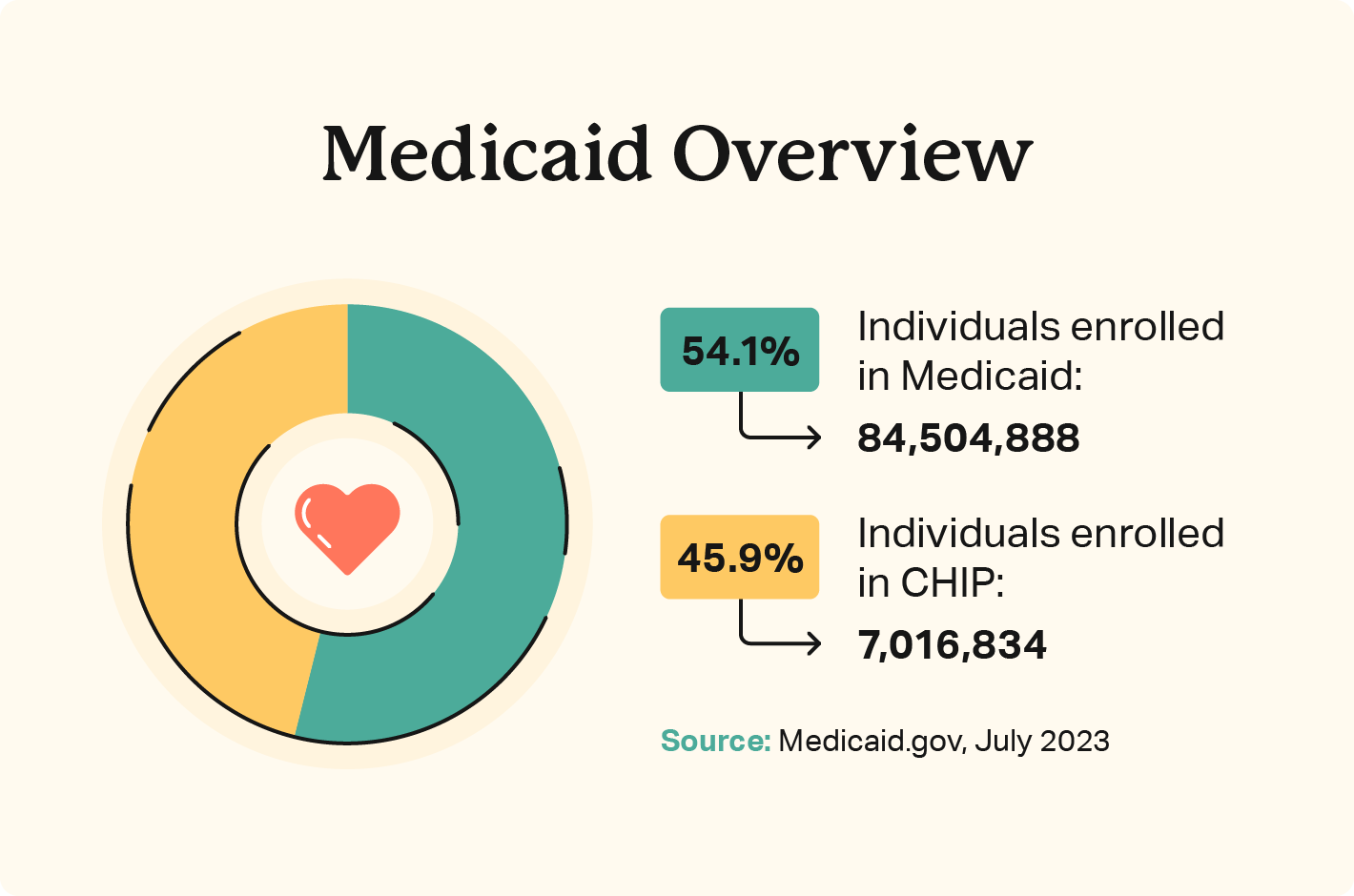Medicaid eligibility varies by state and is generally determined by need, eligibility group, and income. Use the map below or jump to your specific state to explore Medicaid programs and qualifications that may apply to you.
You can also learn more about Medicaid as a whole and additional health care resources here.
Medicaid By State
Step 1
Select an eligibility group:
Step 2
Select a qualifying state:
Key
A common acronym that stands for Aid for Aged, Blind, and Disabled used to represent seniors and disabled people.
Eligibility and income and asset guidelines are based on specific circumstances and conditions. Basic eligibility groups include children, parents and caretakers, pregnant adults, eligible adults, and seniors and disabled people.
Federal poverty limit that’s represented as a percentage.
Income limits are based on family size. Available income limits below include single filers, families of 2 (senior couples and pregnant adults), and families of 4.
The maximum amount a family can make monthly for the eligible members to qualify for Medicaid coverage.
Eligibility is based on need and income limits, and each state has the flexibility to customize their Medicaid qualifications, so your best resource for information will always be your state’s website.
Income limits are the most a family can make for an eligible family member to qualify for Medicaid enrollment. So if a family of four in Alabama makes less than the children’s Medicaid income limit of $3,650 a month, the family’s children meet income qualifications.
Coverage also varies among eligible demographics, and some states cover more people than others with increased income limits or Medicaid Expansion.
Check out these top and bottom states by demographic coverage, then explore your state’s Medicaid program details below.
| Eligibility Group | Highest Coverage | Lowest Coverage |
|---|---|---|
| Children | New Jersey | Massachusetts |
| Parents and Caretakers | District of Columbia | Texas |
| Pregnant Individuals | Iowa | Massachusetts |
| Independent Adults | District of Columbia | Non-expanded states (AL, FL, GA, KS, SC, TX, WI, WY) |
| Seniors and disabled people | California | Hawaii |
Medicaid Overview
Medicaid is a state-administered public health insurance program that provides coverage to low-income families, children, pregnant people, seniors, and people living with disabilities.
This program covers over 84.5 million people living in the U.S., but each state program is different. Eligibility and coverage vary between states and can change from year to year, so connect with your local health and human services office to learn more about your state’s health programs.
Medicaid qualifications
Medicaid eligibility is determined by financial need based on your modified adjusted gross income (MAGI) and financial assets, as well as other conditions, like age or pregnancy. The CMS requires coverage for select groups, including:
- Low-income families
- Qualified pregnant people
- Children
- Social Security Income (SSI) recipients
MAGI-related eligibility applies to non-aged adults, pregnant people and children, and low-income families. States determine what percentage of the federal poverty limit (FPL) qualifies for coverage for each eligibility group.
Eligibility for seniors and disabled people is determined by the Social Security income guidelines, but it can also expand. This eligibility group and program is commonly referred to as Aid to the Aged, Blind, and Disabled (AABD) in government and Medicaid guides.
Medicaid expansion
The 2010 Affordable Care Act aimed to increase health insurance access for Americans, which included legislation to expand Medicaid as one of three primary goals.
In the 41 states that have expanded Medicaid, adults making less than 138% FPL can qualify for Medicaid on financial status alone (state FPL guidelines may vary), regardless of age, family status, or disability.
Only ten states haven’t adopted Medicaid expansion, meaning adults younger than 65 without a disability, caretaker status, or pregnancy aren’t eligible for Medicaid coverage, regardless of their financial status. States without expansion include:
- Alabama
- Florida
- Georgia
- Kansas
- Mississippi
- South Carolina
- Tennessee
- Texas
- Wisconsin
- Wyoming
How to apply for Medicaid
Since Medicaid is managed and administered by state agencies, your state’s website will have specific application forms, eligibility tools and requirements, and processes for application.
Most states accept online applications, or you can mail your application to a specified Health and Human Services location or other Medicaid agency. Applications will ask for:
-
- Proof of identity (birth certificate, proof of citizenship)
- Proof of income (pay stubs, tax returns)
- Bank statements
- Assets (property, retirement accounts)
- Insurance policies (health, life, long-term care)
- Burial arrangements (funeral contracts, owned burial plots)
Medicaid open enrollment lasts until December 15, 2023, for 2024 coverage. After your application is approved, your benefits will begin on January 1.
Medicaid Resources And Alternative Assistance
Most states have health care benefits beyond Medicaid to support low-income families. The first place to look for additional coverage is your local HHS office, which can help you navigate available programs and determine your eligibility.
Check out these resources if you’re looking for more information on Medicaid programs and benefits:
- CMS Nursing Home Toolkit for Medicaid Beneficiaries
- CMS Hospice Toolkit for Medicaid Beneficiaries
- Children’s Health Insurance Program (CHIP)
- Insure Kids Now resources for children
If you don’t qualify for Medicaid or need additional assistance, look into these resources:
- Health Insurance Marketplace health plan finder
- Health Insurance Marketplace local assistance finder
- DOL COBRA Continuation Coverage for workers
- DOL Health and Employee Benefits resources
Life Insurance Living Benefits For Care
Medicaid programs support families that don’t receive employer-sponsored healthcare or can’t afford high private coverage premiums. It’s a great program to close the gap for low-income families, and there are other steps you can take to help manage your health costs.
Some permanent life insurance policies have a tax-deferred savings cash value that policyholders can borrow from while alive. This can be a good alternative to cover Medicaid fees or other services state programs may not cover.
Plus, the value collects interest, and any unused funds can cover your funeral expenses or provide for your estate.
- Nationally licensed life insurance agent with over 15 years of experience
- Personal annual production that puts him in the top .001% out of all life insurance agents in the nation.
Anthony Martin is a nationally licensed insurance expert with over 15 years of experience and has personally served over 10,000 clients with their life insurance needs. He frequently authors entrepreneurial and life insurance content for Forbes, Inc.com, Newsweek, Kiplinger, and Entreprenuer.com. Anthony has been consulted as an expert life insurance source for dozens of high-profile websites such as Forbes, Bankrate, Reuters, Fox Business, CNBC, Investopedia, Insurance.com, Yahoo Finance, and many more.
- Nationally licensed life insurance agent with over 19 years of experience
- Best selling Amazon author.
Jeff Root is a nationally licensed life insurance expert with over 19 years of experience. He has personally helped over 3000 clients with their life insurance needs. Jeff is a best-selling Amazon author and the managing partner of a highly successful insurance brokerage that manages over 2,500 licensed insurance agents across the USA. He has been a featured life insurance source for prestigious websites such as Forbes, Bloomberg, MarketWatch, Nerdwallet, and many more.
- Nationally licensed life insurance agent with over 14 years of experience
- Best selling Amazon author of five insurance sales books.
David Duford is a nationally licensed insurance expert with over 14 years of experience. He has personally helped more than 15,000 clients buy life insurance. David has been featured as an expert source for highly authoritative publications such as A.M. Best and Insurancenewsnet. He also runs one of the largest Youtube channels to help aspiring insurance agents serve their clients better.
- Nationally licensed life insurance agent with over 19 years of experience
- Best selling Amazon author.
Jeff Root is a nationally licensed life insurance expert with over 19 years of experience. He has personally helped over 3000 clients with their life insurance needs. Jeff is a best-selling Amazon author and the managing partner of a highly successful insurance brokerage that manages over 2,500 licensed insurance agents across the USA. He has been a featured life insurance source for prestigious websites such as Forbes, Bloomberg, MarketWatch, Nerdwallet, and many more.
- Nationally licensed life insurance agent with over 14 years of experience
- Best selling Amazon author of five insurance sales books.
David Duford is a nationally licensed insurance expert with over 14 years of experience. He has personally helped more than 15,000 clients buy life insurance. David has been featured as an expert source for highly authoritative publications such as A.M. Best and Insurancenewsnet. He also runs one of the largest Youtube channels to help aspiring insurance agents serve their clients better.
Choice Mutual often cites third-party websites to provide context and verification for specific claims made in our work. We only link to authoritative websites that provide accurate information. You can learn more about our editorial standards, which guide our mission of delivering factual and impartial content.
-
covers over 84.5 million people. https://www.medicaid.gov/medicaid/index.html
-
requires coverage for select groups. https://www.medicaid.gov/sites/default/files/2019-12/list-of-eligibility-groups.pdf
-
federal poverty limit (FPL). https://aspe.hhs.gov/topics/poverty-economic-mobility/poverty-guidelines
-
2010 Affordable Care Act. https://www.hhs.gov/healthcare/about-the-aca/index.html
-
less than 138% FPL can qualify for Medicaid. https://www.healthcare.gov/medicaid-chip/medicaid-expansion-and-you/
-
administered by state agencies. https://www.medicaid.gov/about-us/beneficiary-resources/index.html#statemenu
-
Medicaid open enrollment. https://www.healthcare.gov/
-
CMS Nursing Home Toolkit for Medicaid Beneficiaries. https://www.cms.gov/medicare-medicaid-coordination/fraud-prevention/medicaid-integrity-education/downloads/nursinghome-beneficiary-booklet.pdf
-
CMS Hospice Toolkit for Medicaid Beneficiaries. https://www.cms.gov/medicare-medicaid-coordination/fraud-prevention/medicaid-integrity-education/downloads/hospice-overviewbooklet.pdf
-
Children’s Health Insurance Program (CHIP). https://www.medicaid.gov/chip/index.html
-
Insure Kids Now resources for children. https://www.insurekidsnow.gov/
-
Health Insurance Marketplace health plan finder. https://www.healthcare.gov/get-coverage/
-
Health Insurance Marketplace local assistance finder. https://www.healthcare.gov/find-assistance/
-
DOL COBRA Continuation Coverage for workers. https://www.dol.gov/agencies/ebsa/laws-and-regulations/laws/cobra
-
DOL Health and Employee Benefits resources. https://www.dol.gov/agencies/ebsa/key-topics/health-and-other-employee-benefits










